Apple's iPhone 4: Thoroughly Reviewed
by Brian Klug & Anand Lal Shimpi on June 30, 2010 4:06 AM EST- Posted in
- Smartphones
- Apple
- iPhone 4
- Gadgets
- Mobile
Camera Usability
It still takes almost two seconds to activate the camera on the 4, which is enough time to miss whatever it is you’re trying to grab a photo of. Thanks to the iOS 4 update however, the shutter is almost instantaneous. The difference appears to be that the photo is committed to memory but not fully written to NAND, whereas before the photo would be written to the Flash before you could take another picture. Power loss in the middle of snapping photos seems pretty rare on a smartphone so the tradeoff, if I’m correct, makes sense.
Apple opted for a lower noise rather than higher resolution sensor in the iPhone 4 and it did pay off. The main camera shoots photos at 2592 x 1936 compared to the EVO 4G’s 3264 x 1952, but the resulting images are far less noisy - particularly in low light situations:
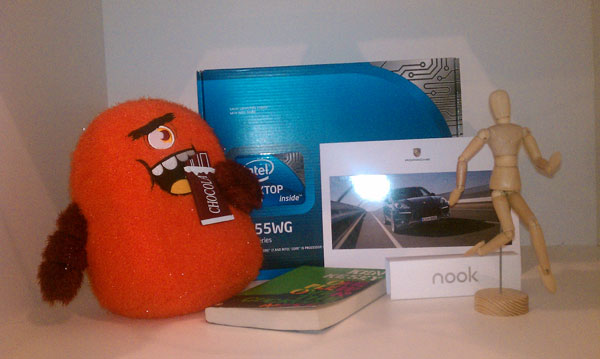
HTC EVO 4G - Low Light
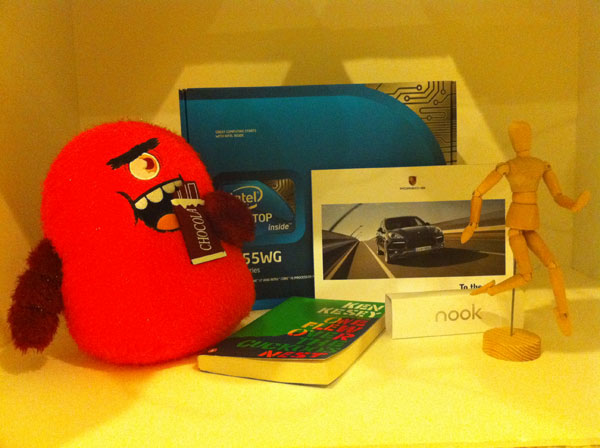
Apple iPhone 4 - Low Light
The 4’s main camera, like the HTC Incredible and EVO 4G, is a decent replacement for a point and shoot if you’re primarily outdoors. You’re still going to get better image quality out of a good point and shoot, but the tradeoff is convenience. The limitations are significant.
Because you rely on the iPhone 4’s software controlled aperture and shutter speed you don’t have the ability to properly expose the image. You have to rely on Apple’s algorithms, which tend to either overexpose outdoors or miscalculate white balance with non-halogen light sources.
This is an example of a photo taken outdoors that’s more washed out than it needs to be:

And many of you picked up on the white balance issue I snuck into our EVO 4G review yesterday:

Regardless of where I tapped to focus, I could not get the iPhone 4 to set a proper white balance in our photo box.
While I was watching the screen, the iPhone 4 would alternate between yellow and white for the background color. It seemed to be trying to calculate the white point but was just being thrown off by the type of light. If I timed the shot right I could snag the photo while the iPhone was switching between white balance points:

I also had this problem in my office which uses LED can lights.

This is far more yellow than it should be
While Brian didn't have the same problems I did, Brandon Hill (DailyTech Editor in Chief) did. It seems to be very dependent on the type of lighting you have and even then it seems to vary based on the type of CFLs. And unlike the EVO 4G, there’s no way to manually set a white balance on the 4.
For overall image quality though I have to hand it to Apple, the iPhone 4 does do a better job than the EVO 4G or other phones I’ve used. Take a look at this shot inside my house:
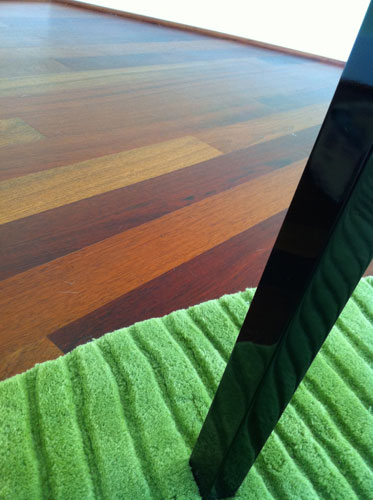
The colors in the iPhone 4 shot are on point. The green is correct, the wooden floor is right and the black is, well, black. The EVO 4G didn’t do so well on this test by comparison:
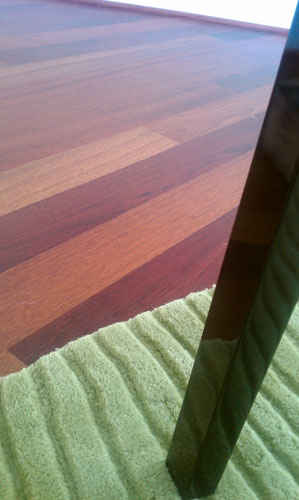
The 4’s camera isn’t perfect, but it does appear to handle colors better than the EVO (with the exception of my white balance issue) and delivers lower noise photos.
Compared to other phones the 4 does similarly well, besting the 5 megapixel camera in the Motorola Droid easily in terms of color reproduction and sharpness. Though the HTC Incredible previously was a top performer alongside the N900, the iPhone 4 makes the Incredible look a bit oversharpened and artificial. Compared to the 3GS, the iPhone 4's improvement is obviously dramatic, as shown in the gallery below.
Video is recorded at 1280x720, in H.264 with AAC mono audio. We measured a bitrate of 1.35 MBps, outclassing all the other smartphones we've tested.
iPhone 4
HTC Droid Incredible
Motorola Droid
Nokia N900
What's interesting is that the iPhone 4 appears to crop the sensor down for video recording, taking the center most 1280x720 pixels instead of scaling down the entire image size. The result is that the focal length for video recording is notably longer than when taking photos.
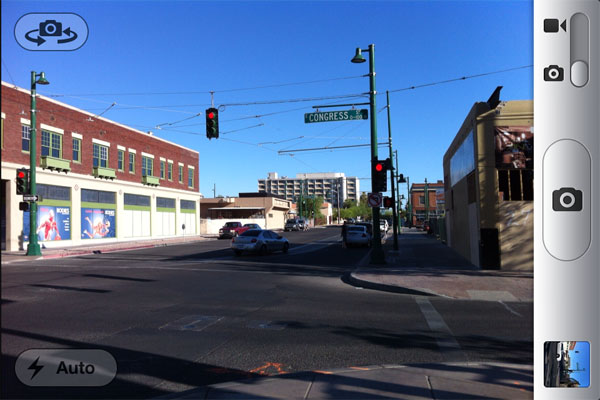
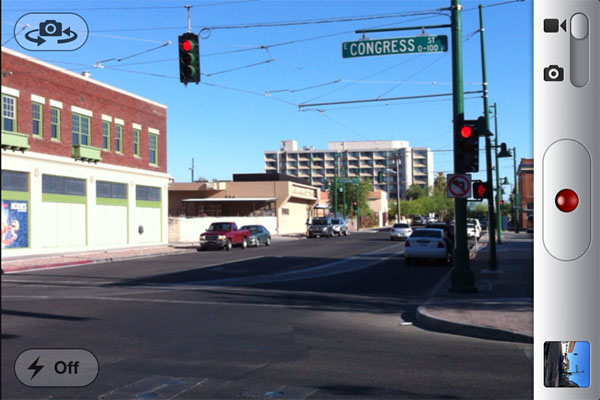
You can see the difference is quite notable standing in the same place. Perhaps the A4 SoC lacks the compute power to apply a scale and encode at the same time, necessitating this crop. Whatever the case, video shot with the iPhone 4 still looks very good at the promised and delivered 30 FPS. Move the camera around enough, and there's still screen door effect from the rolling shutter like any CMOS sensor is going to give you - it's a fundamental problem no phones are going to get around soon. Its also right there in the specifications page for the camera SoC; rolling shutter.
Similarly, iPhone 4 does give you 5x digital zoom, though we still maintain you're better off taking photos at native resolution and messing with them later with better interpolation algorithms.
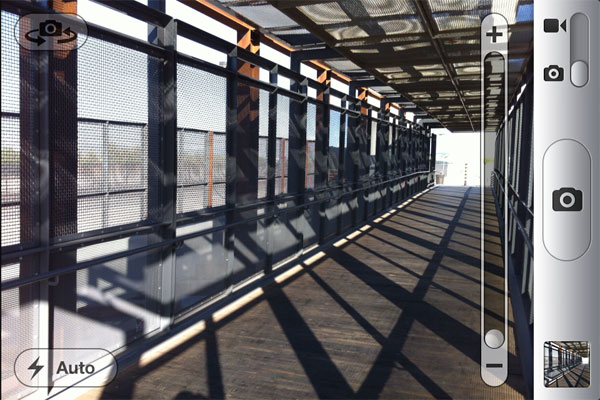
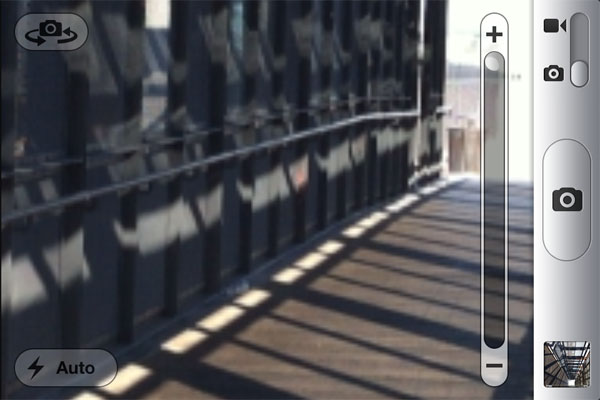






















270 Comments
View All Comments
Mumrik - Friday, July 2, 2010 - link
Stop that shit. We all know major iPhone (iPod, Windows, Intel CPU etc.) releases matter more for the industry and the majority of people so it is only natural that they put more work into these articles that are going to get more readers. There is one iPhone out there at a time but a gazillion competing Android phones. They can't cover them all like this - that is why they put extra effort into articles that cover Android itself.I say this as someone who has sworn to never own an Apple product.
Henry 3 Dogg - Thursday, July 1, 2010 - link
Re your final comment"Changing the bars visualization may indeed help mask it [the signal drop], and to be fair the phone works fine all the way down to -113 dBm, but it will persist - software updates can change physics as much as they can change hardware design."
From my own tests, I think that you are missing something here.
When you bridge the left corner line and see the signal strength drop, it does so over the course of several seconds. One would tend to assume that this is time averaging in software BUT...
if you make a call in a very weak signal area and then bridge the gap, the call degrades and possibly drops in the same way i.e. over the course of several seconds.
If the whole effect is physics, then the call should degrade instantly - but it doesn't.
Clearly there is a physics effect, but it also appears that the phone software is responding to this physics effect in a manner that makes it more of an issue.
It may/should be possible, by software changes, to make the final signal degradation when the gap is bridged, no more that it is immediately the gap is bridged, and in all honesty that would pretty much close the issue.
Personally I just don't bridge the gap, and then I find, like you did, that I can simply use this phone in places that I've never been able to use a mobile before.
This really is the best phone yet.
John Sawyer - Thursday, July 1, 2010 - link
"It may/should be possible, by software changes, to make the final signal degradation when the gap is bridged, no more that it is immediately the gap is bridged, and in all honesty that would pretty much close the issue."Hopefully this is what Jobs meant when he said, "Stay tuned."
mmike70 - Friday, July 2, 2010 - link
Maybe calls are more forgiving because I haven't had one drop yet. What does happen is when I hold the iphone4 normally in my left hand (I'm right handed, tap with the right hand fingers, hold with the left), the data connection drops immediately. I'm not talking even over the course of five seconds. The currently loading web page will stall the instant I pick the phone up. This is in an area with a very close tower, constant 5 bars on an iphone 4 and 3gs. I can't cradle, grip, pinch, cover, etc the 3gs to make any detectable difference in data performance.chinkgai - Thursday, July 1, 2010 - link
Hey Brian or Anand,Just wanted to point out that on my wireless N/G with the same speedtest.net app tests, my download speed usually always tops out around 10700-11000 kbps, so I'm not sure why you're getting such a low speed on average. It also maxes out my upload speed which is far lower than yours. I'm on a 16/2 line here in Los Angeles.
Great article though!!
bparun - Thursday, July 1, 2010 - link
Obviously a good thorough review. Why is there not a good amount of detail about the newly added Gyroscope in iPhone 4? I have read that its the electronic version of a vibrational one. More on that would be a nice read, as the future of games and apps using this gyroscope for augmented reality would be in abundance. I am sure all the other phone manufacturers are ready to follow, as usual.Mumrik - Friday, July 2, 2010 - link
Such a minor feature in the larger perspective...John Sawyer - Thursday, July 1, 2010 - link
It seems to me, that if the iPhone 4's signal is attenuated when one's hand bridges the gap between the two antennas on the lower left side, but not if one bridges the two antennas by holding the iPhone 4 at its sides, above the gap, that one possible fix for the future, might be to move the gaps so that they're at the topside left and underside left, so one's hand (left or right) doesn't touch the gaps (I doubt many people cover the bottom or top edges of their phones while in use). This would allow the lengths of the two antennas to remain nearly the same, and so it might not compromise the original antenna design's signal strength, unless the original design relies on the upper and lower left corners/ends of the two antennas to be untouched by a user's hand, which would be stupidly unnatural (as nearly everyone notes). If full antenna strength does require these two corners/ends to be uncovered, does this mean the iPhone 4's main radiating signal power, for both antennas, emits from the upper and lower left corners/curved ends of the two antennas, rather than from the entire length of the antennas? If the entire length of both antennas send/receive, moving the gaps to topside left and underside left wouldn't seem to greatly affect the right-side UMTS/GSM antenna's exposure to the world (more critical than the left Bluetooth/wifi/GPS antenna's exposure, since a cell tower is usually further away than a local wireless router, etc.), no matter which hand it's held in (can't say the same for the left-hand antenna, but that may not be important due to closer proximity of wireless routers, etc.); but if the signals for both antennas send/receive mainly from one end of each antenna (currently the curved ends), requiring them to have some uncovered access to the world, then what about moving the gaps closer to the center-top and center-bottom locations? I have a hunch that these potential end-radiating points don't have to be curved, as they currently are at the corners, but maybe I'm wrong. However, this would make both antennas nearly the same length, which might affect signal strength too, if the different frequencies sent/received by the two antennas require their lengths to be as they currently are.
If Apple doesn't want do anything like that (or if the antenna design doesn't allow for it), or even to coat the exposed metal antenna with some kind of clear coat (if that even helps enough), it might be best to move the antennas back inside, wrapped around the inside of the case--I don't think too many users will moan about not being able to touch metal around the sides of the iPhone. Another approach (which would work for either internal or external antennas) might further improve the antenna: two antennas for the phone signal, one at each lower corner (since FCC phone-to-head maximum radio signal level requirements now force manufacturers to put the phone antenna in the bottom of new cellphones), with whichever one that's not covered by the user's hand being used (circuitry in the phone could detect this).
iwod - Thursday, July 1, 2010 - link
1. I dont know why no one mentioned it in their reviews. And only Anand manages to point out my same thoughts, Why no insulation coating on the Stainless steel? It add less then 1mm of thickness and is cheap and easy enough to do so.The only reason would be Apple Engineer were using 3GS casing while they were testing..
2. No one mentioned the new Skyworks Baseband chip. I have never head of them, and dont know how good they are. Wiki shows they have been in the business for nearly a decade now, so that should be good. The Less Drop calls on iPhone 4 were more to do with this Chips instead of AT&T network upgrade. The previous Infineon Chipset were simply poor. It was Infineon first chip into communication and mobile network. And it didn't work well although the problem were easily pointed to AT&T network. It wasn't only AT&T were having drop calls, Every iPhone 3G user in the world were having drop calls with different Network. And the Drop Calls rate for iPhone 3G/3GS on AT&T were much higher then any other phones on AT&T network. That simply points to a problem the lies within iPhone.
3. The iPhone A4 is a package on package SOC. The Memory was Dual Channel Low Power DDR. Why didn't they use Low Power DDR3? It is lower power and faster then ancients DDR.
4. Why didn't Apple upgrade their GPU? The iPhone 4 is 4x as much resolution. Playing Games on it requires much more computational power.
5. 110ppi may not be enough for desktop. But how many ppi would a Retina Display for Desktop and Notebook need? I just measure we are typlically at least 24 inch away from the monitor, double the distance as you would hold on a iPhone. If a iPhone 4 requires 330 ppi, then Double the distance would half the ppi, which means 165ppi, That means 2560 x 1200 Resolution for 18" Display. For a Large Desktop Display 27", you will need 4K ( 4096×1716 ) resolution, which is actually perfect for Digital Film making and Broadcasting. I think it is time we distinguish a Computer Display to Normal TV. They can keep with their 1080P for as long as they want. We want Retina Display on our Mac.
( Notes: However even the lastest DisplayPort 1.2 does not offer enough bandwidth for 4K resolution )
6. Software Side - Some Reports indicate iOS 4.0 uses more memory then older iOS 3.0 which more useless process standby ( Such us Internet tethering and Bluetooth.exe even when both features are OFF ). While they may only consumer 2 - 3MB of memory. It is still a lot on a mobile devices. I hope anand can verify if they have time.
7. Saferi on iOS 4.0 seems to be using a older version of WebKit as well. I am sure SunSpider will run faster and on par with Andriod once Apple update iOS.
brownreese - Thursday, July 1, 2010 - link
I am blown away by the thoughtfulness of this review. Too many sites read like regurgitated press releases. I have just become a lifelong reader. Thanks.